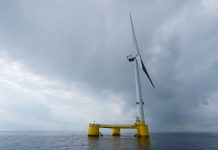National Grid increased spending on UK backbone electricity transmission last year by 3% to £1.072 Billion, its results for the year to March published today reveal.
Main capex beneficiaries included power trunks from Hinkley Point, site of the new £23 billion nuclear generator, and the Power Tunnels 2 project under London. Also supported was the ESO’s SmartWires project. This uses AI to aggregate renewable power more intelligently over existing circuits, thereby avoiding outlay on new infrastructure.
Overall group capital investment dropped 4% to £5.047 billion over the year, chief executive John Pettigrew told investors. Spending on the UK gas transmission system plummeted 29%, to £0.18 billion, as the company pursued its focus on Britain’s increased electrification.
In America, the ESO spent nearly three times as much as in the UK, last year’s outlay of £3.2 billion underpinning nets delivering US regulated services.
Group pre-tax profit, including US operations, dropped 3% to £2.407 billion. In the face of continuing heavy investment and the Covid pandemic, Pettigrew hailed the figures as ‘a solid underlying financial performance’.
Costs of March’s announced purchase of Western Power Distribution, Britain’s biggest DNO, into are yet to feature in today’s announcement. It integration is set to be finalised by August.
Flex services
In advance of the competition regulator’s (CMA) decision – expected this summer – on its RIIO-T2 appeal, NG developed new market-based services aimed at inviting market players to profit from balancing the Britain’s grid.
Last spring, it launched Operational Downward Flexibility Management – a temporary marketplace to reduce output from renewable generation.
In September, NG fired up its new fast frequency response service, Dynamic Containment. Working with generators and big consumers, the ESO advanced its Pathfinder projects, identifying how voltage, stability and constraint management services provided by fossil fuel generation can be replaced with lower carbon approaches.
During the year Ofgem agreed to fund the ESO’s RIIO-2 business plan, approving (98%) of £504m of the costs the company identified out for its first two years. Pettigrew greeted Ofgem’s regulatory changes as enabling the transition to a zero-carbon electricity system.
Over the coming five-year RIIO-2 period, the CEO said, NG’s activities pledged under RIIO-2 will generate net benefits of around £2 billion for consumers, and lower average annual consumer bills by around £3.
In January, Ofgem recommended Britain should have an independent system operator, fully separated from National Grid. Pettigrew said NG was “working closely with the government, regulator and industry to explore what changes will be needed to achieve net zero, to ensure system reliability, and to ensure fair recompense for shareholders should the decision be made to pursue this recommendation”.
Pettigrew claimed the operator had accepted the “majority” of arguments made in Ofgem’s Final Determination on RIIO-2, the system of cost allocation designed to ensure fair and profitable access to a reliable national backbone.
Over RIIO-2’s forthcoming five years of price control, NG will spend around £8 billion will be investment in asset health, in reinforcement of the Electricity Transmission system, mainly links to offshore generation and other new onshore connections.
National Grid has appealed to competition regulator the CMA on some aspects of the RIIO-2 judgement. A decision is expected later this year. Its delivery will signal the stepping down of NG’s UK executive director, Nicola Shaw, her post becoming redundant under the new trading regime.
At 13:00 today National Grid’s share price was 940.70 pence, a rise of 1.1%.



